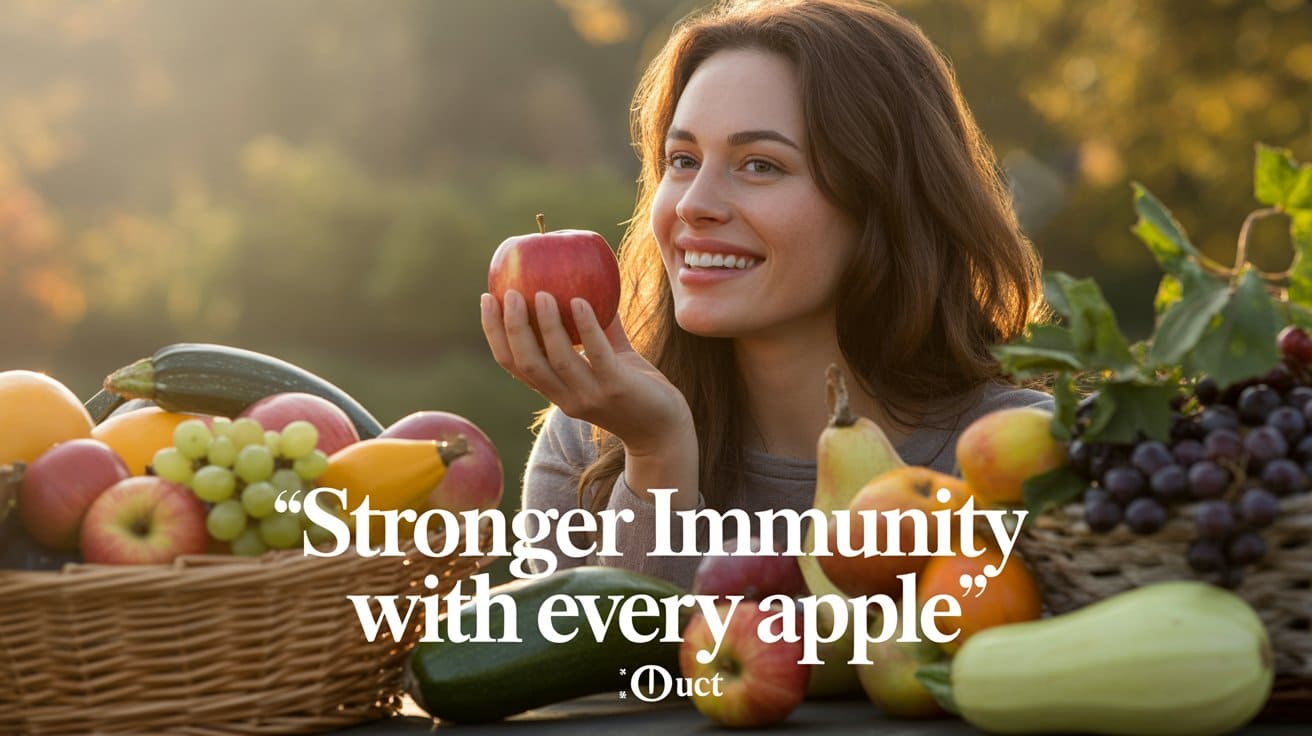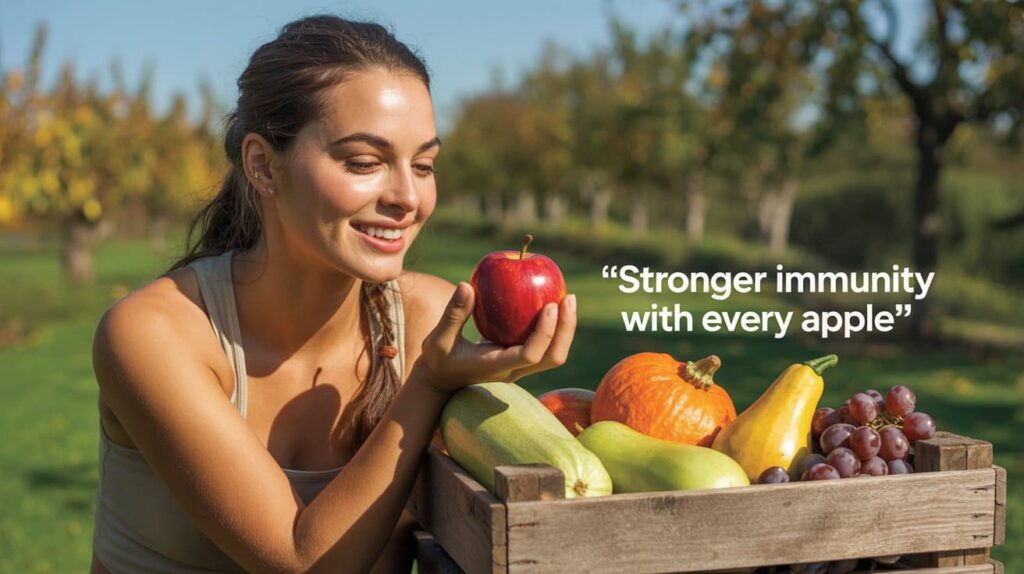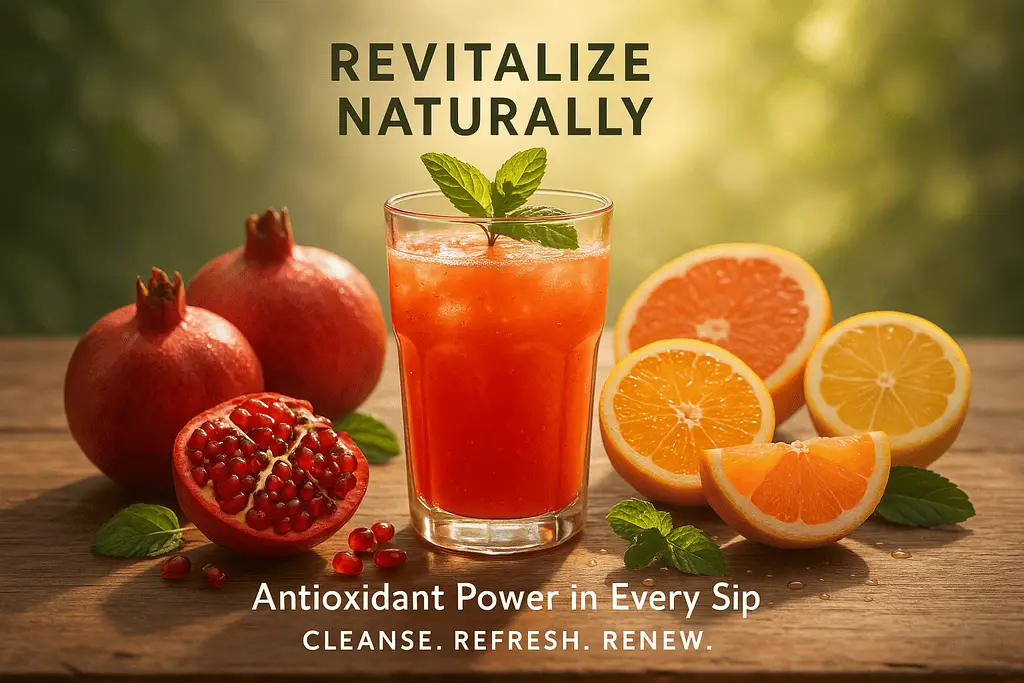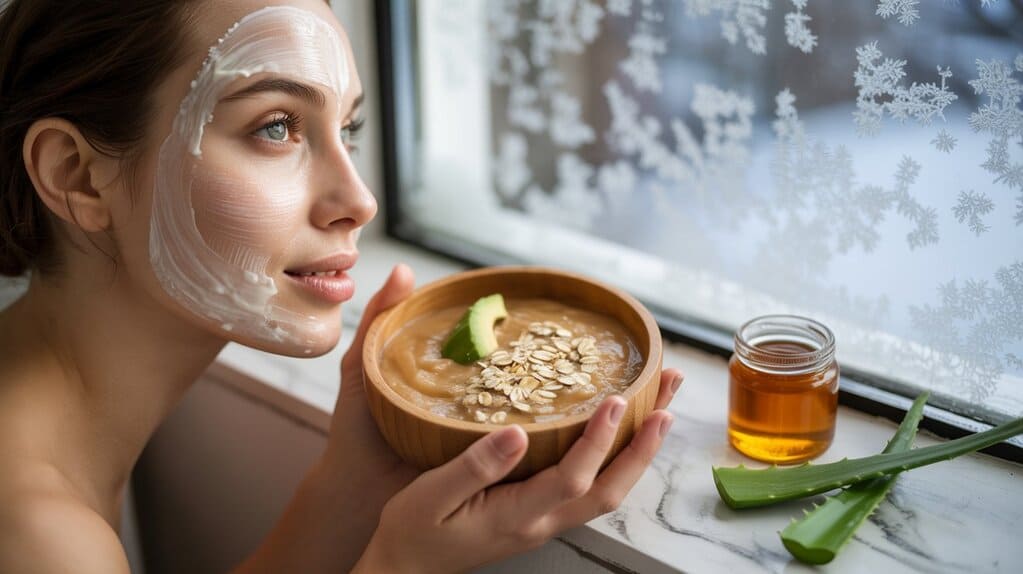
Introduction
Few foods are as universally accessible—and as quietly powerful—as the apple (Malus domestica). From street markets in Marrakech to supermarkets in New York and farm stands across Europe, apples offer a compact package of dietary fiber, polyphenols (such as quercetin, catechins, and procyanidins), vitamin C, and water—nutrients and bioactives linked to heart, metabolic, gut, and brain health. Beyond folk wisdom (“an apple a day…”), modern nutrition science from Asia, America, and Europe has dug into apples’ specific compounds and population-health effects, finding consistent signals that make apples a strategic, everyday choice for optimal health and wellness. WikipédiaMy Food Data
This article synthesizes up-to-date evidence with an SEO-friendly structure to help you (and your readers) understand why apples deserve superfruit status, how to choose and use them, and what the latest peer-reviewed research suggests about disease risk reduction. You’ll find key points, tables/figures, bolded keywords, and citations to reputable sources (including Wikipedia, USDA, and medical journals).

Key Points (Executive Summary)
- Apples are rich in soluble fiber (pectin) and polyphenols—notably quercetin concentrated in the peel—supporting cardiovascular, metabolic, and gut health. My Food DataPMC
- Whole-apple intake is linked with lower risk of type 2 diabetes in large US cohorts; fruit juice shows the opposite trend. PMCPubMed
- Asian randomized trials of apple polyphenols report reductions in visceral fat and favorable lipid effects, suggesting a role in weight and metabolic management. PubMedJ-STAGE
- European research (EPIC and related analyses) associates higher fruit/veg patterns—including apples—with lower cancer and cardiometabolic risk, while emphasizing minimally processed foods. PMCiarc.who.int
- Keep the peel: quercetin and other flavonoids are concentrated in apple skin, and emerging work suggests neuroprotective and anti-inflammatory benefits. ACS PublicationsScienceDirect
- For best glycemic and satiety benefits, eat whole apples, pair with protein or nuts, and favor lower-added-sugar preparations. PMC

Body
1) What’s inside an apple? (Nutrition & bioactives)
A medium raw apple with skin (~182 g) provides ~95 kcal, ~4–5 g fiber, ~10% DV vitamin C, potassium, and abundant polyphenols. While apples aren’t protein- or fat-dense, they excel at low-calorie volume, hydration, and prebiotic fibers that feed beneficial gut bacteria. Authoritative nutrient profiles from the USDA FoodData Central and clinical nutrition sites consistently report ~52 kcal per 100 g, ~2.4 g fiber per 100 g (≈4+ g per medium fruit). fdc.nal.usda.govMy Food Data
From a phytochemical standpoint, quercetin, catechin/epicatechin, chlorogenic acid, and procyanidins dominate apples’ protective toolkit. Classic and contemporary reviews highlight apples’ flavonoids and their roles in anti-inflammatory signaling, endothelial function, and oxidative-stress reduction. PMC+1
Figure 1. Apple at a glance (per 100 g, raw with skin)
Calories ~52 kcal | Fiber ~2.4 g | Vitamin C ~4–6 mg | Potassium ~107 mg | Water ~86% | Polyphenols: quercetin, catechins, chlorogenic acid, procyanidins (qualitative)
Sources: USDA FoodData Central; peer-reviewed reviews on apple phytochemicals. fdc.nal.usda.govMy Food DataPMC
Peel power. Multiple analyses show higher flavanol and quercetin concentrations in the peel than in the flesh—sometimes several-fold—making whole, unpeeled apples (well-washed) the evidence-based default for maximum benefit. Quantitative studies report flavanols in peel ≈320–564 mg/100 g DW (variety-dependent) and quercetin typically 2–7 mg/100 g fresh weight in whole apples. ACS Publicationsmitchell.ucdavis.edu
Botany & background. For taxonomic and cultural context, see Wikipedia’s Apple entry, which traces domestication and global spread from Central Asia—useful for general readers and SEO. Wikipédia
2) Cardiometabolic health: fiber + flavonoids working together
Heart health and vascular function. Systematic reviews of flavonoids and population studies suggest that higher intakes from foods like apples may support lower cardiovascular risk, though individual cohort results vary (a hallmark of nutrition epidemiology). The big picture—integrating mechanistic, cohort, and clinical data—leans positive for blood pressure, lipids, and endothelial effects. PMCScienceDirect
Metabolic health and visceral fat (Asia). In Japanese randomized and long-term intake trials, apple polyphenols (rich in procyanidins) reduced visceral fat area (VFA) over 8–12 weeks and modulated lipid metabolism. These trials, led by researchers such as Akazome and colleagues, highlight an Asian evidence stream supporting metabolic benefits beyond calories and fiber. PubMedJ-STAGE
Type 2 diabetes risk (America). Analyses from large US cohorts (Nurses’ Health Study, Health Professionals Follow-Up Study) show that greater whole-apple intake is associated with lower type 2 diabetes risk, while fruit juice associates with higher risk—a practical, patient-friendly distinction. In one pooled analysis, apples were among the individual fruits inversely associated with diabetes risk. PMCPubMedBMJ
Cancer risk (Europe & global meta-analysis). A systematic review/meta-analysis found that apple consumption correlates with reduced risk across several cancer sites, complementing broad European data (e.g., EPIC) linking higher fruit/veg intake and lower incidence/mortality for common cancers. While apples aren’t “medicine,” their fiber-polyphenol matrix plausibly contributes to risk reduction via anti-inflammatory, antioxidant, and microbiome pathways. PMC+1
Table 1. Apples & major health outcomes—what the evidence suggests
(Observational = population associations; RCT = randomized controlled trial)
Outcome Study type & region Signal Notes Type 2 Diabetes Cohorts (USA) ↓ risk with whole apples; ↑ risk with juice Consistent across multiple cohorts; substitution matters. PMCPubMed Visceral fat / Metabolic RCTs (Japan) ↓ visceral fat area with apple polyphenols Procyanidin-rich extracts/beverages; adjunct to diet. PubMedJ-STAGE Cardiovascular Reviews & cohorts (US/EU) Generally favorable; mixed by cohort Mechanistic support via flavonoids; fiber aids lipids/BP. PMCScienceDirect Cancer Meta-analysis; EPIC (Europe) Inverse associations Part of overall minimally processed plant-rich patterns. PMC+1

3) The “active ingredients”: quercetin, procyanidins, and pectin
- Quercetin (a flavonol) is concentrated in apple peels and has been explored for cardioprotective, anti-inflammatory, and neuroprotective roles. A 2023 clinical-epidemiologic study linked higher dietary quercetin with lower odds of frailty over 12 years, reinforcing functional aging benefits of quercetin-rich foods like apples. Laboratory and review work from Europe also underscores quercetin’s broad bioactivity. PMCScienceDirect
- Procyanidins, abundant in apple polyphenols, modulate lipid metabolism, may inhibit digestive enzymes, and (in rodent models) prevent diet-induced obesity—a mechanistic layer that supports the human VFA findings. J-STAGEPMC
- Pectin, apples’ soluble fiber, acts as a prebiotic, feeds SCFA-producing microbes, and contributes to LDL-cholesterol lowering and glycemic smoothing when eaten as whole fruit. (These effects are blunted in juice due to fiber removal.) PMC
4) Practical guidance: how to get the most health from apples
- Eat the peel (after washing): that’s where quercetin and total flavanols cluster. If texture is a barrier, try finely slicing or grating apples into salads/oats to disperse peel. ACS Publications
- Prefer whole apples to juice for satiety and glycemic control; if you enjoy cider, pair with meals rich in protein/fat to slow absorption. PMC
- Pairings that pop (and steady blood sugar): apples + nuts, yogurt, cheese, or seed butter add protein and healthy fats.
- Variety matters: tart Granny Smiths tend to be higher in certain polyphenols, while red-skinned varieties concentrate quercetin in the peel—rotate types through the week. (Polyphenol profiles vary by cultivar, peel color, and growing conditions.) ACS Publications
- Cooking tips: light sautéing or baking preserves much of the benefit; avoid heavy added sugars. Keep peels on in crisps, porridges, and tray bakes.
- Special situations:
- Weight management: consider an apple 10–15 minutes before meals for a fiber-and-water preload.
- Digestive sensitivity/FODMAPs: some individuals with IBS may tolerate cooked apple better than raw.
- Allergies: people with birch pollen allergy may experience oral allergy symptoms with raw apple; cooking often helps.

5) FAQs (science-backed, reader-friendly)
Do apples really “keep the doctor away”?
No single food does, but regular apple intake—as part of a whole-food, plant-forward diet—aligns with lower risks for several chronic diseases in observational research, with mechanistic and clinical support for specific outcomes (e.g., visceral fat, lipids). PubMedJ-STAGEPMC
Which apple is “healthiest”?
There’s no single winner. Red-skinned apples tend to deliver more quercetin in the peel, but tart cultivars may carry higher total polyphenols. Mix varieties to diversify flavonoids and enjoy seasonal flavor. ACS Publications
Can apples help with blood sugar?
Yes—whole apples (thanks to fiber/pectin and intact cell structure) are associated with lower diabetes risk in cohorts; conversely, fruit juice is linked with higher risk. Pair apples with protein/fat for a steadier glucose curve. PMCPubMed
What about cancer prevention?
A 2016 meta-analysis associates apple consumption with reduced cancer risk across several sites; EPIC findings support fruit/vegetable patterns (including apples) and lower processing as part of a prudent strategy. Apples are not a cure, but they fit a science-based prevention plate. PMC+1iarc.who.int
6) Tips & usage ideas (with keywords)
- Snack: “apple slices with almond butter” for satiety, fiber, and healthy fats.
- Breakfast: “overnight oats with grated apple and cinnamon” for gut-friendly fiber and polyphenols.
- Salad: “kale–apple–walnut salad” for antioxidants, omega-3s, and magnesium.
- Warm dessert: “baked apples with oats and nuts”—keep peel on to retain quercetin.
Use bolded keywords naturally throughout your content: apples, quercetin, apple polyphenols, pectin, fiber, heart health, diabetes prevention, gut microbiome, weight management, antioxidants, cancer risk, immune support, whole fruit, apple peel, low glycemic snack.
Conclusion
When judged by nutrition density, bioactive diversity, global availability, and culinary versatility, apples comfortably earn “superfruit” status. The fiber-polyphenol synergy in apples—especially when you eat the peel—aligns with lower diabetes and cardiovascular risk, healthier visceral fat profiles, and potential anti-cancer and healthy-aging signals across American, Asian, and European research. The practical guidance is simple: choose whole apples, vary the variety, pair for balance, and keep the peel. As part of a minimally processed, plant-forward pattern, apples are a small, delicious habit with an outsized payoff for optimal health and wellness. PMC+1PubMed
References (selected)
Authoritative overviews & nutrition facts
- Wikipedia: Apple—history, botany, varieties. Wikipédia
- USDA FoodData Central—nutrient profiles for raw apples with skin. fdc.nal.usda.gov
- Healthline, “Apples 101: Nutrition Facts and Health Benefits”—consumer-friendly synthesis based on research and USDA data (updated 2025). Healthline
Phytochemicals & mechanisms
4) Boyer & Liu. Apple phytochemicals and their health benefits. Nutr J (2004). Foundational review on apple polyphenols. PMC
5) Popiołek-Kalisz J. Apple Peel Supplementation Potential in Metabolic Syndrome. Nutrients (2023). Peel-centric cardiometabolic insights. PMC
6) Kaeswurm JAH et al. Bioaccessibility of Apple Polyphenols from Peel and Flesh. J Agric Food Chem (2022). Quantifies peel vs flesh flavanols. ACS Publications
7) Lee J et al. Pharmacokinetics of Quercetin from Apples and Onions in Humans. (2012). Quercetin amounts and absorption context. mitchell.ucdavis.edu
Cardiometabolic and metabolic outcomes
8) Peterson JJ et al. Do Flavonoids Reduce Cardiovascular Disease? Nutrients (2012). Review of flavonoids and CVD outcomes. PMC
9) Hooper L. Flavonoids, flavonoid-rich foods, and cardiovascular risk. Am J Med (overview). ScienceDirect
10) Muraki I et al. Fruit consumption and risk of type 2 diabetes (NHS/HPFS). BMJ (2013). Apples linked to lower diabetes risk; juice to higher risk. PubMedPMC
11) Akazome Y et al. Apple polyphenols and visceral fat. J Oleo Sci (2010) + related Japanese trials. PubMedJ-STAGE
Cancer & broad European evidence
12) Fabiani R et al. Apple intake and cancer risk: meta-analysis. Public Health Nutr (2016). PMC
13) EPIC/IARC communications and reviews on diet and cancer risk. Lancet Planet Health news and EPIC summaries. PMCiarc.who.int
Healthy aging and neuro topics
14) Oei S et al. Higher intake of dietary flavonols, specifically quercetin, and lower frailty odds. Am J Clin Nutr (2023). PMC
15) Ichwan M et al. Apple peel and flesh contain pro-neurogenic compounds. EBioMedicine/Stem Cell Reports family (Cell Press journal indexing via ScienceDirect)
Mini Table: Quick comparison—whole apple vs. apple juice
| Feature | Whole apple (with peel) | Apple juice |
|---|---|---|
| Fiber (pectin) | High (2–4+ g per fruit) | Minimal/none |
| Satiety | High (chewing, volume) | Lower |
| Glycemic impact | Steadier | Higher |
| Polyphenols | Concentrated in peel | Some retained, but variable; processing losses |
| Evidence on diabetes risk | Inverse association | Positive association (higher risk) |
| Practical tip | Wash, keep peel, pair with protein | Limit, or pair with meals |
Sources: USDA; NHS/HPFS cohort analyses; peel polyphenol studies. fdc.nal.usda.govPMCPubMedACS Publications
Final word
If you’re looking for one simple, sustainable habit that aligns with heart, metabolic, gut, and healthy-aging goals—choose a whole apple with its peel most days. It’s affordable, portable, delicious, and backed by multi-continent research that consistently points in the same direction: small daily choices add up. Apples are an easy one to win. PMC+1PubMed
Note : This article curates evidence from Asia (e.g., Japanese RCTs on apple polyphenols), America (US cohorts like NHS/HPFS and Framingham), and Europe (EPIC/IARC and European reviews), plus USDA and Wikipedia for foundational facts—balancing mechanistic, clinical, and population-level perspectives for a practical, SEO-optimized guide.







